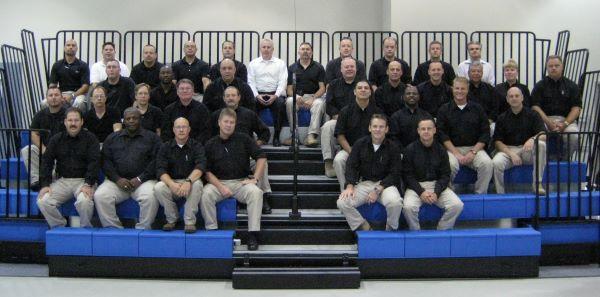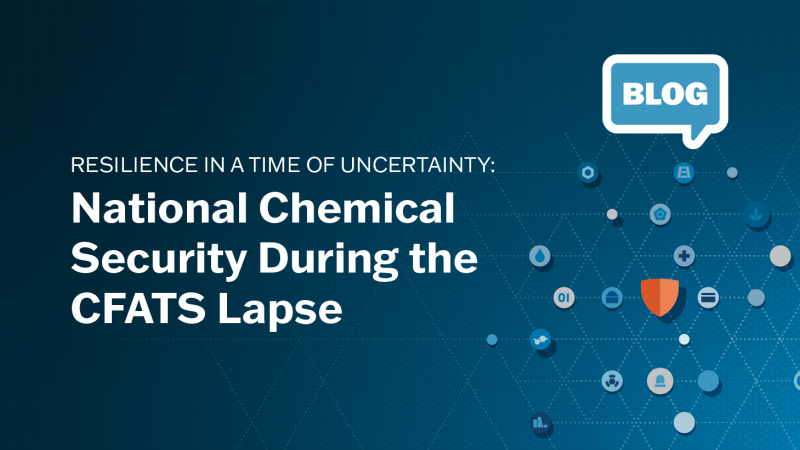Bringing the Regulation to Life: Chemical Security Inspectors and the First CFATS Inspections

This is the third post in a series about the origins of the Chemical Facility Anti-Terrorism Standards (CFATS) program. We encourage you to start with How It All Began: The History and Making of the CFATS Program and CFATS: Building a Foundation – Appendix A.
In our previous post, we focused on Appendix A, a document that has been instrumental to the implementation of the CFATS program and has helped facility owners and operators understand their chemical holdings and the security issues that may come with those chemicals.
In this post, we continue the story of the CFATS program by focusing on the glue that holds the CISA Chemical Security program together: its people. Among all of the people it takes to implement the Chemical Security programs, the inspectors based across the country who make up the Chemical Security Inspector (CSI) cadre are as vital to the securing of our nation’s facilities as the security measures themselves. Our inspectors contribute to the consistent support from industry and to CISA’s reputation for working with facilities, not against them.
Before the Interim Final Rule was published in April 2007, the Chemical Security Working Group (the original predecessor to what is now CISA Chemical Security) knew that they were going to need more than the 10 to 15 lawyers, policy makers, scientists, and security professionals responsible for writing the CFATS program’s regulations and policies. The program was going to need boots on the ground to implement the regulation across the country.
DHS looked within the Department to identify staff who could serve temporarily—known as detailees—to stand up the inspector side of the program. The group they looked to was the Federal Protective Service (FPS), whose workforce commonly had law enforcement and security specialist backgrounds. Within FPS was an even more specialized subset: those who had gone through HAZMAT technician training, mostly for the purpose of conducting law enforcement response that involved hazardous materials or dangerous chemicals. Travis Walker, an FPS inspector detailed to support the development of the new program, was tasked with the challenge of recruiting this new cadre. A notice went out to all FPS inspectors, especially those with a chemical security background, to volunteer for the inaugural CSI cadre.
In February 2007, after two days on the phone fielding the numerous inquiries from volunteers, Walker had found about 40 men and women for the job. The Interim Final Rule was on track for publication in April but had not yet been finalized, and Walker was next tasked with looking at what was needed for these detailees to perform the role of inspector for the brand-new regulatory regime.
“The problem was, we were trying to teach people how to do something that hadn’t yet been defined,” said Walker, who today serves as Chemical Security’s Program and Management Operations Branch Chief. “The first set of classes stuck to the basics. We couldn’t teach them the regulation yet because it didn’t even exist.”
What they did have was other regulations, instructors with diverse backgrounds, and help from an FPS investigator who also happened to specialize in instructional design. The first Inspector Academy took place at a fire academy in Kentucky in early 2007. There, the inaugural group of inspectors spent several weeks in classes that ranged from molecular chemistry, safety training, and travel procedures to using personal protection equipment (PPE) and learning about other regulations from the Occupational Safety and Health Administration (OSHA) and the Environmental Protection Agency (EPA). Eventually, the class went to visit facilities with chemical holdings in Kentucky and Texas to see what it would be like to conduct an inspection.

Once the Final Rule was published, facilities began to fill out Top-Screens, the survey used to report chemical holdings to DHS. From the onset, much of the work of the inspectors focused on was providing assistance. “Initially, it was, ‘[here’s] a Top-Screen and how to fill it out,’” said Wade Townsend, another detailee from FPS who went on to join the CFATS team and has continued to enjoy a successful career at CISA. “Then, [it was] how to complete a security plan that would meet the program’s nonprescriptive needs.” In fact, because of the newness of the program, inspectors initially did not conduct inspections at all. Instead, they were focused entirely on outreach, assistance, and education.
Every one of the more than 300 chemicals listed in Appendix A is there because DHS is concerned that it could be exploited in a terrorist attack. It was up to the inspectors to help facilities understand what they had on site that fell under the regulation, why DHS was concerned about their specific chemicals, and then to assist the facility with identifying appropriate security measures based on the amount of each chemical and its security issue.
The relationships between inspector and facility were key to the partnership model that is still in effect today. “We treated them as colleagues and peers,” said Townsend. “We wanted to foster a relationship and work with the facilities to help protect the American people. We were there to help them understand and comply with this regulation, not just to enforce it.”
In addition to assisting facilities with wrapping their heads around the CFATS requirements, the inspectors conducted outreach to increase awareness about the program. They gave speeches at conferences, worked with Local Emergency Planning Committees (LEPCs), talked to first responders, and coordinated with industry to get the word out—a large part of their role to this day.
“We wanted to fight the stigma of a regulatory program,” said Townsend. “We wanted to hear what the facilities were saying and bring that back to headquarters. We weren’t there with the badges and ticket books; we were all about handshakes and complying with the regulation.”
Small but mighty, the team was spread across the country conducting outreach to communities and stakeholder groups large and small. “We would talk to five people in a café one day, then 500 people in an auditorium the next,” said John Farrell, one of the original inspectors and current Chemical Security Compliance Branch Chief. “We never said no to anyone who requested us. We were everywhere from corporate barbeques to volunteer firehouses.” The inspector cadre began to grow in earnest in 2009 and 2010, and many members of the original team of detailees began transitioning to permanent positions with the CFATS program.
Despite the team’s efforts to quickly stand up an inspection force and process, by 2011, the inspectors’ efforts remained almost entirely focused on outreach and education; the program had conducted only 10 authorization inspections at high-risk sites. “The CFATS risk-based performance model provides us with amazing flexibility,” stated Kelly Murray, the Associate Director for Chemical Security. “But with that flexibility comes complexity, for both industry and government, as we built out our internal processes and policies when it came to reviewing, evaluating, and inspecting security plans.” To address the slow start to reviewing facilities’ security plans and conducting inspections, in 2011, DHS stood up a team to overhaul its approach and retrain its inspector cadre—this time focusing on the regulations themselves and how to implement them.
By 2012, DHS began regularly conducting authorization inspections at high-risk sites, and was finally on track to address the backlog of facility inspections and site security plan approvals that had built up since the program was established.
"Unlike today, when we started ramping up inspections, we would have five or six CSIs on-site,” said Farrell. The Agency sent out large inspection teams to learn from and about the facilities. “Our personnel were able to see and understand the diverse, complex universe that made up the Chemical Sector. It’s not all smokestacks on a turnpike or what you’d normally picture as a manufacturer,” said Farrell.
Today, there are more than 150 inspectors across the country and U.S. territories. The inspectors cover every region of the U.S., as well as Puerto Rico, the U.S. Virgin Islands, Guam, American Samoa, and Commonwealth of Northern Mariana Islands. They drive thousands of miles each year to inspect and assist the facilities in their areas. Since the inception of the CFATS program, CSIs have conducted nearly 15,000 inspections, more than 10,000 compliance assistance visits, and tens of thousands of outreach activities including conferences, meetings, and webinars.
“Over the years, the inspection process and the role of the inspector have evolved tremendously,” said Region 4 CSI Kathy Ward. She credits this evolution to the lessons learned from being out in the field and to the relationships that inspectors and facilities have built over the years.
Feedback from the regulated community has been instrumental to improving the CFATS inspection process. Over the years, industry has helped generate ideas for resources that DHS has developed to assist with compliance—like the “What to Expect from a CFATS Inspection” guide and the RBPS 18 – Records sample records template. They provided advice that led to the creation of a CFATS Corporate Approach to authorization inspections, which streamlines inspections at participating companies with multiple facilities and corporate level policies. They have also shared suggestions on how to more efficiently conduct authorization and compliance inspections in a way that limits disruptions to facilities’ daily business while providing DHS with the information it needs to ensure that security is in place and adequate to the threat.
For the men and women who make up the CFATS inspection force, the job continues to offer fresh perspectives and opportunities for new experiences. CSIs are jacks and jills of all trades: they need to be well-versed in the chemicals they’re regulating, in the evolving world of physical and cybersecurity, and how to work with people of all kinds. Oftentimes, CSIs are the face of the CFATS program to the public. Whether engaging with facility security officers, owners and operators, emergency response officials, or state or local officials, inspectors represent CFATS in every state of the country.
“I love what I do because there is always an opportunity to provide value,” said Rodney Lockett, Chief of Chemical Security for Region 7, who joined as a CSI in 2009. “I enjoyed the ability to be innovative during the early years of the CFATS program—where the possible only seemed unattainable—in reality, the challenges, changes, and maturity made the CFATS program and Chemical Security as a whole, a joy and what it is today. Watching our program earn credibility within the industry, with our local, state, and federal partners, and internationally continues to excite me.”
Want to learn more about the inspection process? Visit the CFATS Covered Facilities and Inspections webpage or email CFATS@hq.dhs.gov to get in touch with your local CSI.
More on CFATS 15th Anniversary
Learn more about the CFATS 15th Anniversary.





